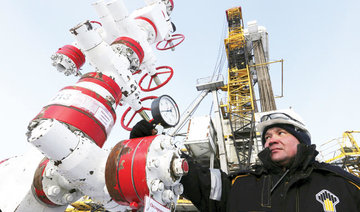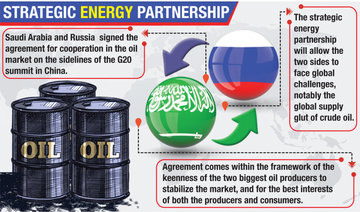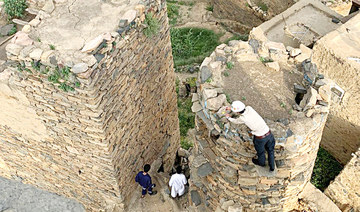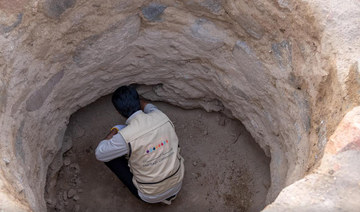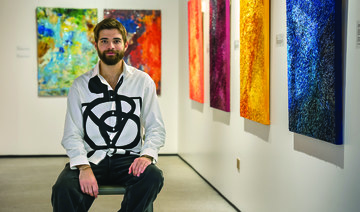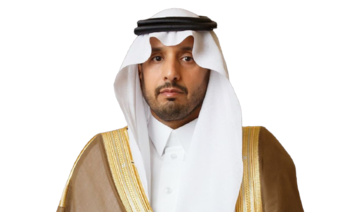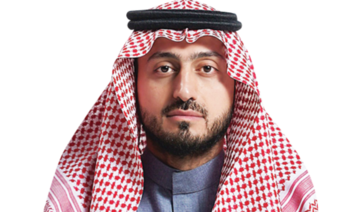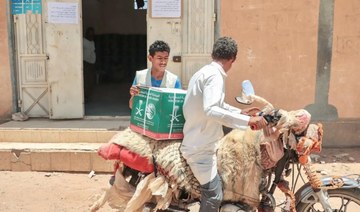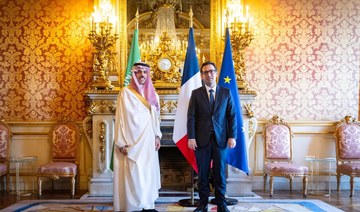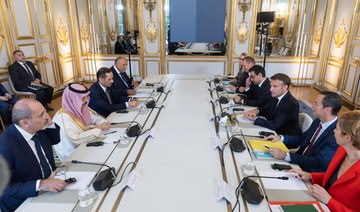RIYADH: The Kingdom is set to start a new chapter in its overall relations with Russia, and herald a new era of Saudi-Russian economic cooperation following the high-profile visit of King Salman, which begins on Thursday.
Russia, no doubt, will be a new addition to the list of Saudi Arabia’s most-favored nations, with which it will enter into a strong strategic economic alliance within the days to come.
Saudi-Russian relations, which took off during the visit of Crown Prince Mohammed bin Salman to Russia in May within the framework of Vision 2030, will be further consolidated during the visit of King Salman.
Several agreements including memoranda of understanding (MoU), predominantly in the fields of energy, economy and commerce, have been lined up for signing between the two countries during the royal trip.
No doubt, Saudi Arabia is intensifying its diplomatic efforts to start a new era on the commercial front. During the visit to Russia of Crown Prince Mohammed bin Salman, the Saudi side expressed a desire to develop strong cooperation with Russia in investment, space exploration, residential construction and other areas.
Back in June, on the sidelines of the St. Petersburg International Economic Forum, an agreement was signed on long-term bilateral cooperation in the peaceful use of nuclear energy. The two countries also identified that the most promising areas of cooperation are energy, geological exploration, mining, petrochemicals, tanker construction, investment cooperation, and training of personnel.
This is apart from the interest evinced by the Russian Direct Investment Fund (RDIF) and the Saudi agencies to cooperate.
On the trade front, the two countries have forged closer ties. Total trade exceeds $1 billion, but these are the figures of the past. In fact, the commercial landscape between Riyadh and Russia will rapidly and substantially change following the visit of King Salman.
Referring to the agreements to be signed by Riyadh and Moscow during King Salman’s visit to Russia, a Reuters report said that Saudi Arabia is expected to sign several memoranda with Russian companies during the royal visit. State oil giant Saudi Aramco and Saudi Basic Industries Corp. (SABIC) will sign a memorandum with Russia’s biggest petrochemical company Sibur to look for opportunities to build petrochemical plants in both countries.
The agreement is one of several due to be signed during King Salman’s visit to Russia this week, his first trip to Moscow since becoming king in 2015. Other agreements expected to be signed include a memorandum between Saudi Aramco and Novatek, Russia’s biggest non-state gas producer, to look for investment opportunities in the gas sector, said the Reuters report. Local Saudi Aramco and SABIC officials declined to comment on the possible deals.
Regarding other agreements to be signed by the two sides, Kirill Dmitriev, the head of the sovereign RDIF, on Tuesday said that “the fund was in the final stage of negotiations with Saudi partners about major Russian projects in the Kingdom,” without giving specifics. He said, however, that the fund and its Saudi partners would announce the creation of a new investment platform in energy sectors, as well as investments in industry and infrastructure.
Moreover, the Russian side has also expressed interest in Saudi Arabia’s renewable energy sector, where the Kingdom was looking for major investments to help it produce 10 percent of its power from renewable sources. Also, Saudi Arabia is looking at nuclear energy to meet rising domestic power demand so more of its crude oil can be exported or converted into petrochemicals, rather than being used to generate electricity.
Dmitriev said that significant results have been achieved in the area of investment cooperation under a joint $10 billion framework created by the RDIF and Saudi Arabia’s Public Investment Fund (PIF). Dmitriev told Reuters in June after the RDIF agreed to buy a stake in Russian oil services company Eurasia Drilling, that the fund would also welcome Saudi investment in the company.
He said Saudi investors were already involved in a number of highly profitable projects in Russia, in sectors such as petrochemicals, infrastructure, logistics and hydropower, among others. Russia and Saudi Arabia will also unveil a “large” deal in the infrastructure sector later this week with Riyadh investing in toll roads in Russia including in Moscow, Dmitriev, said on Monday.
Russia’s interest in Saudi Arabia is multidimensional. Economically, Russian-Saudi understandings on oil production and oil exports can significantly affect global markets, Russia’s economy and the Russian government’s federal budget, which still depends heavily on oil-related tax receipts despite declining energy prices.
“Moscow also sees Saudi Arabia as a potential source of investment, something of growing importance,” said Hanif A. Amin, a local banker.
Amin said that “the visit of King Salman to Russia will herald a new era of commercial cooperation, which will go a long way in changing the economic landscape of the two countries, besides political discourses on the key regional issues.” Moreover, economic conditions in Russia in turn shape Russia’s domestic political environment as well as economic conditions in the country.
King Salman’s visit will herald new era of Saudi-Russian economic cooperation
King Salman’s visit will herald new era of Saudi-Russian economic cooperation
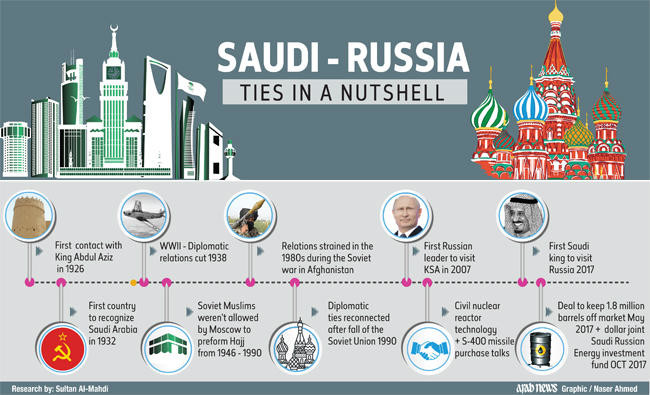
Ancient castles in Sabya governorate reflect architectural heritage
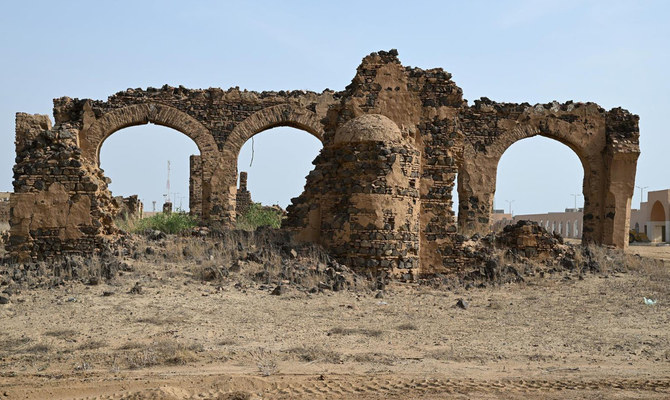
- The Sabya Archaeological Castle has origins that date to the early 20th century
RIYADH: The Sabya governorate in the Jazan region is a treasure trove of archaeological wonders, each with its own unique story.
Among these is the Sabya Archaeological Castle, whose origins date to the early 20th century. The castle, steeped in history, is a must-visit for any archeology enthusiast or researcher.
The castle is situated near Sabya Avenue, within King Fahd Park. It is part of the present city of Sabya, which offers a view of Wadi Sabya.
The Sabya Archaeological Castle, an architectural marvel, boasts spacious rooms with high ceilings and thick walls. The walls, adorned with beautiful geometric and floral patterns, are a testament to the skill of the craftsmen who built them.
Local materials such as volcanic stone, wood, and limestone were used during construction. Some accounts suggest that the clay used in making bricks was sourced from the banks of Wadi Sabya.
The use of volcanic stones of various sizes and shapes in particular gives the castle a unique and captivating beauty. The stones were obtained from volcanoes near the city, including Jabal Akwa, located a short distance northeast of Sabya.
The mosque, situated north of the castle, was also constructed using the same building materials as the castle and other structures in the area. It was intended for prayers and gatherings of religious leaders, dignitaries, and the people of Sabya. Its mihrab, or prayer niche, still stands despite some damage.
Some accounts suggest the presence of remains of other buildings in the vicinity of the castle, opening the possibility of conducting archaeological excavations to reveal more secrets about this site.
The Kingdom’s Heritage Commission is diligently working to preserve the Sabya Archaeological Castle, recognizing its significance as one of the most important archaeological sites in the Jazan region.
Artist captures Saudi charm with digital works
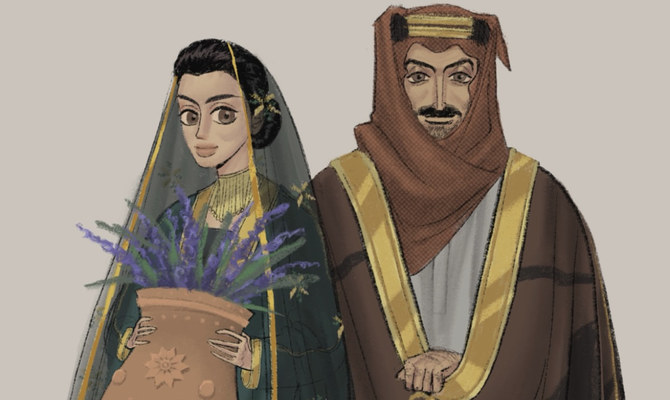
- Ghada Al-Shammari says art can be a means to showcase nation’s rich heritage
RIYADH: Timeless Arabic songs and heartfelt poetry provide the inspiration for Ghada Al-Shammari’s digital art, which showcases the Kingdom’s culture and society.
Al-Shammari's first artwork in 2017 was inspired by a popular Saudi song by Majed Al-Esa called “Hwages,” which means “concerns” in English.
The music video provided a comment on society by using satire, showcasing women driving cars, skateboarding, and playing basketball — activities that at the time were not easily accessible for women.
“I liked how they portrayed women in the traditional Saudi abaya, which motivated me to draw it,” Al-Shammari told Arab News.
For one of her artworks Al-Shammari was inspired by a poem by literary icon Prince Badr bin Abdul Mohsen and popularly performed by the late Saudi singer Talal Maddah.
The drawing depicts a man glancing at a woman who has her eyes downcast, with an oud instrument between them, and the 1980 song title “Forgive Me” written in Arabic text above the illustration.
The Saudi artist said that she tries to capture the poet’s feelings with her artwork, adding: “Romantic songs with descriptions of the poet’s beloved have been particularly inspiring for me.”
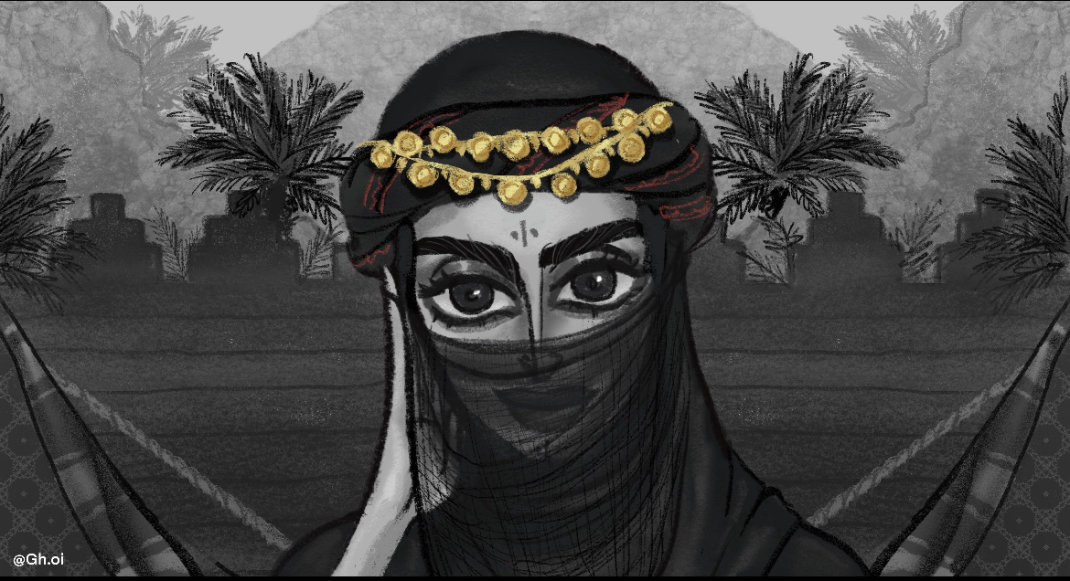
Al-Shammari draws inspiration from the beauty within the Kingdom’s culture. Many of her artworks depict women wearing traditional Najdi-style dresses and gowns with draping silhouettes and glimmering gold headpieces and turbans.
The men are depicted with striking features and wearing traditional garments like the head coverings called ghutra or shemagh, and bisht, the men’s cloak commonly worn in Saudi Arabia and other Gulf countries.
“Saudi culture and traditions have significantly impacted my work. Growing up, I used to think of Saudi Arabia as just what was around me in terms of environment, customs, and traditions,” Al-Shammari said.
When she moved from her hometown of Hafar Al-Batin to the capital Riyadh, Al-Shammari said her friendships and acquaintances showed her a new world of ideas that elevated her artistic vision.
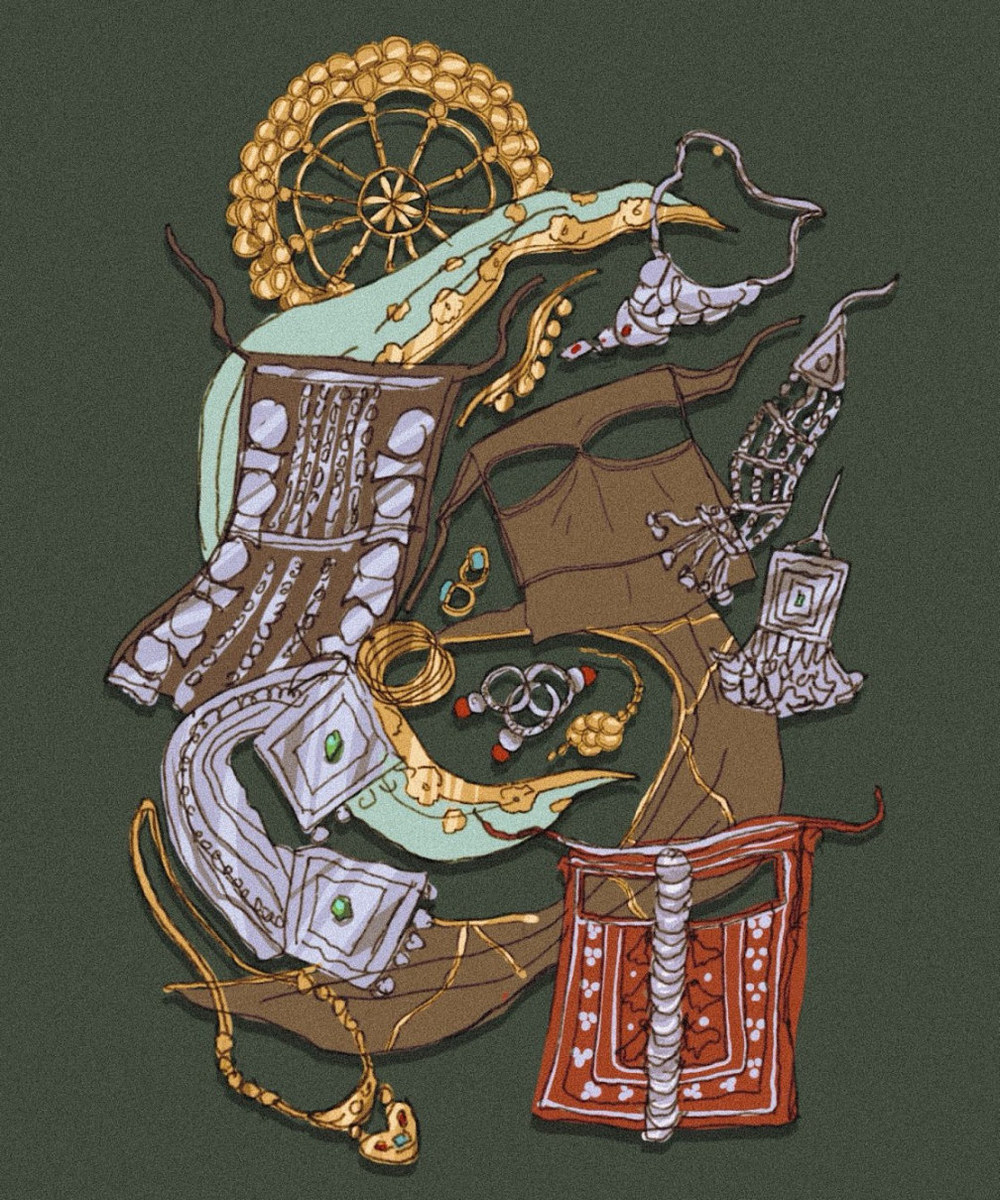
She added: “They shared stories about their region, important landmarks, and fascinating tales that were unique to their areas. This motivated me to learn more about my country and enjoy drawing the diversity and differences I discovered in my artworks.
“Saudi Arabia is full of exciting things, and its diversity is what fascinates me the most. Each region has its own heritage, traditions, architecture, and unique dialect, which makes me eager to learn more and create works that reflect this beautiful diversity.”
Al-Shammari said she selects particular color combinations to evoke the emotions she aims to convey, opting for brighter colors for her cheerful and vibrant works.

Al-Shammari graduated from the College of Arts and Design at Princess Nourah bint Abdulrahman University with a bachelor’s degree in fine arts.
She added: “Through this specialization, I discovered many artistic and historical aspects, learned about various artists, and got to understand their ideas and philosophies, which transformed my perspective of my work.”
Her love of art began as a child when she would draw characters from her favorite anime and cartoons.
“I started focusing on drawing from an educational perspective at the age of 12 through YouTube tutorials on drawing anime and cartoons, which sparked my artistic journey,” Al-Shammari said.
She added that art is important as it showcases the cultural aspect of a country and its heritage, conveying its history and traditions that help define life in the past and present.
She said: “It serves as a way to preserve and transmit this heritage from one generation to the next, seeking to document knowledge and memories.
“Additionally, from an economic standpoint, art is considered a means to attract tourists interested in discovering the country and its civilization.”
For more information on the artist, visit her Instagram @gh.oi.
Who’s Who: Joseph Rank, Lockheed Martin’s CEO for KSA and Africa
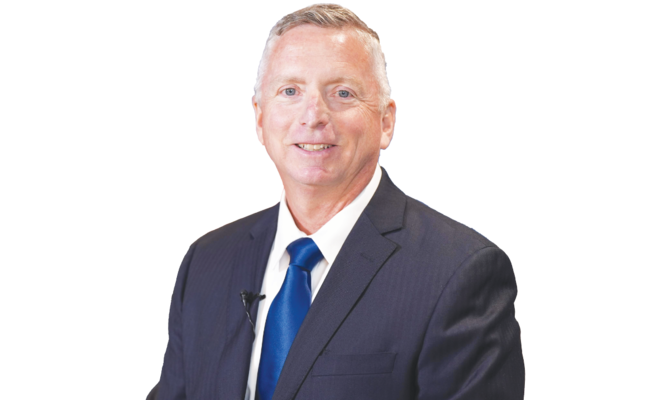
Joseph Rank is Lockheed Martin’s vice president and CEO for Saudi Arabia and Africa.
Rank is a retired US Army brigadier general who has lived in the Kingdom for more than five years.
He served as acting deputy assistant secretary of defense for Middle East policy for former secretary of defense James Mattis in his last posting in the Pentagon.
As an Arabic-speaking foreign area officer, Rank focused on the Middle East for the last 25 years, with postings to five US embassies and Middle East policy positions in the Pentagon, including with the army, joint staff and office of the secretary of defense staff.
He served as the senior defense attache in four US embassies: The UAE from 2015 to 2017, Jordan from 2011 to 2014, Lebanon from 2010 to 2011 and Yemen from 2004 to 2006.
In addition, Rank served in Egypt for a year from 1998 to 1999 and was also deployed to Saudi Arabia, Iraq and Kuwait for Desert Shield/Desert Storm from 1990 to 1991 with the 1st Infantry Division.
While working overseas, Rank was responsible for all aspects of defense cooperation in the countries he was posted to, including training programs, bilateral exercises and billions of dollars worth of foreign military and defense sales, with the intent of building capacity, enhancing interoperability and strengthening relationships.
KSrelief chief and WHO’s Tedros meet in Geneva, sign agreements worth $20m
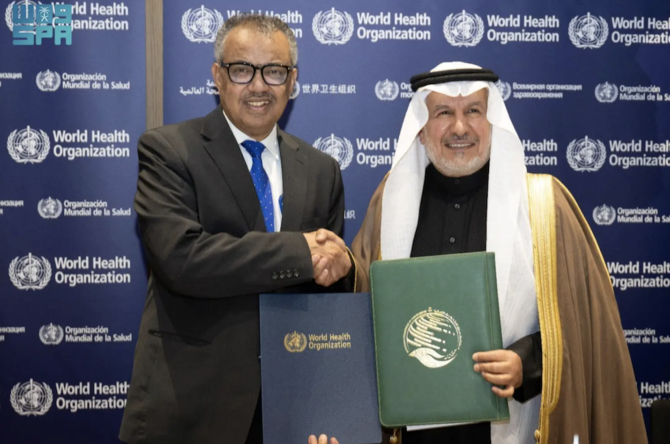
- Al-Rabeeah also signed five executive programs with WHO for Yemen, Sudan, and Syria, with a total value of $19,496,000.
GENEVA: The chief of the King Salman Humanitarian Aid and Relief Center (KSrelief) Dr. Abdullah bin Abdulaziz Al-Rabeeah met with Director General of the World Health Organization (WHO) Dr. Tedros Adhanom Ghebreyesus on Saturday in Geneva.
The meeting was held on the sidelines of the 77th World Health Assembly currently being held in the Swiss city.
Saudi Arabia’s permanent representative to the UN in Geneva Abdulmohsen bin Khothaila also attended the meeting.
During the meeting, the two sides discussed issues of common interest related to joint relief and humanitarian projects in the health sector, as well as the mechanisms for delivering medical assistance to patients and the injured worldwide.
Tedros praised the medical projects and programs carried out by the Kingdom, through KSrelief, to improve the health situation of those in need in various countries.
Also on Saturday, Al-Rabeeah signed five executive programs with WHO for Yemen, Sudan, and Syria, with a total value of $19,496,000.
The first agreement aims to address the severe shortage of kidney dialysis supplies in Sudan to reduce mortality among kidney failure patients across various Sudanese states by providing dialysis supplies sufficient for some 235,000 dialysis sessions, securing 100 dialysis machines, and paying the salaries of medical staff in 77 dialysis centers, with a value of $5 million.
The second agreement entails providing medical assistance to earthquake victims in Syria, with a total cost of $4,746,000.
The third agreement focuses on combating the spread of measles among children under five in Yemen, with a total cost of $3 million.
The fourth agreement aims to improve water and sanitation services in healthcare facilities, ensuring sustainable water supplies to serve the neediest populations in Yemen, valued at $3,750,000. The agreement includes drilling solar-powered wells in 10 healthcare facilities.
The fifth agreement aims to reduce the spread of cholera across Yemen, with a value of $3 million.
Saudi finance minister discusses current global economic outlook with French counterpart
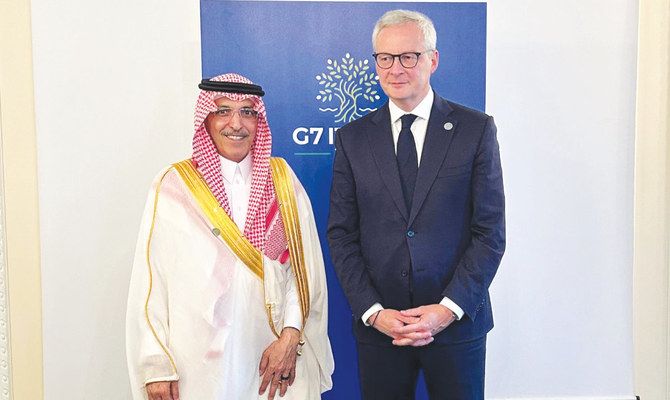
Saudi Minister of Finance Mohammed Al-Jadaan recently met Bruno Le Maire, France’s minister of the economy, finance and industrial and digital sovereignty, at the Group of Seven meeting in Italy to discuss the current global economic outlook and other topics of interest.
Meanwhile, Vice Minister of Finance Abdulmuhsen Al-Khalaf recently met Ethiopia’s State Minister of Finance Semereta Sewasew in Riyadh.
The parties discussed bilateral financial relations and other topics of common interest, the Finance Ministry reported on X on Saturday.


